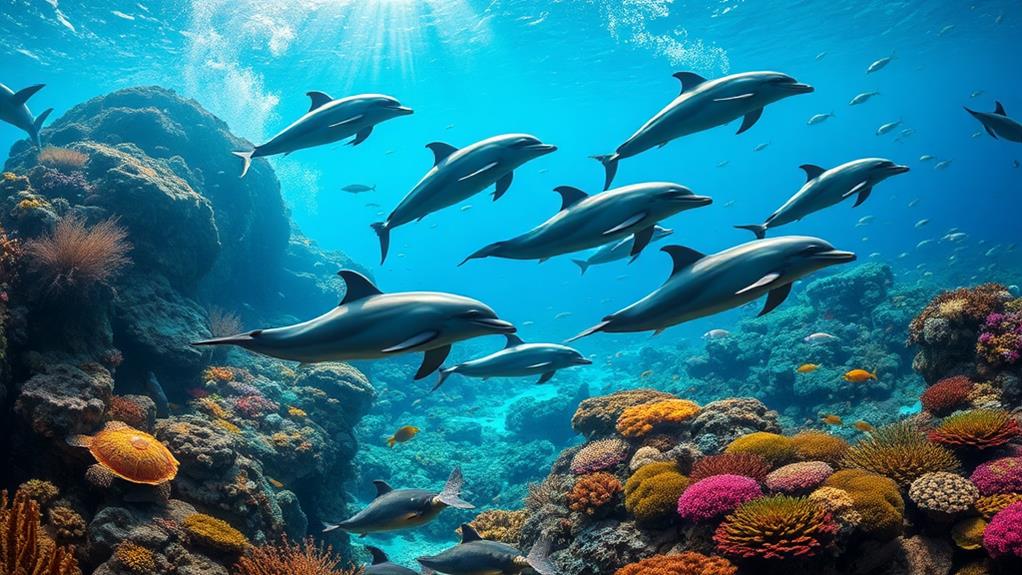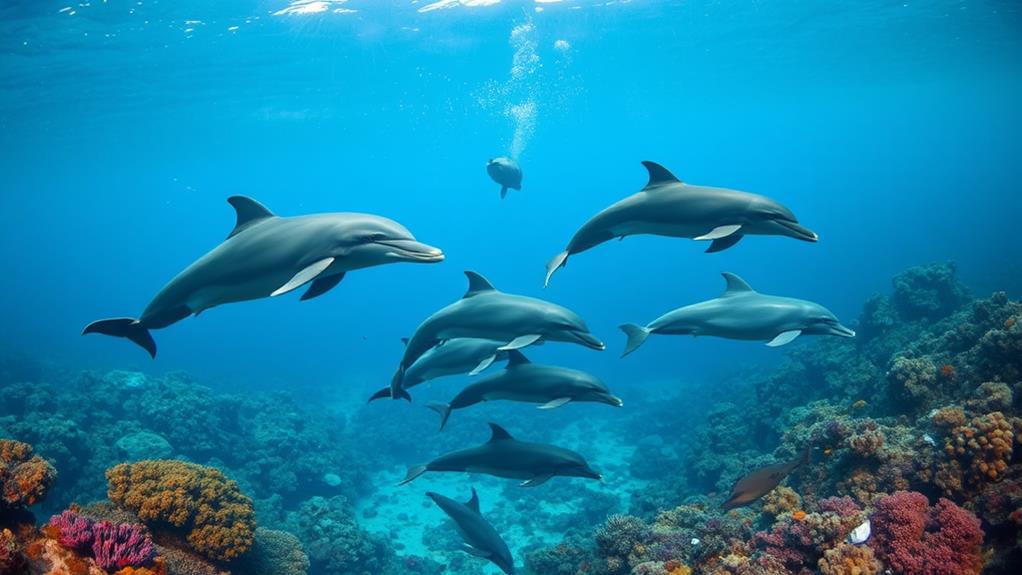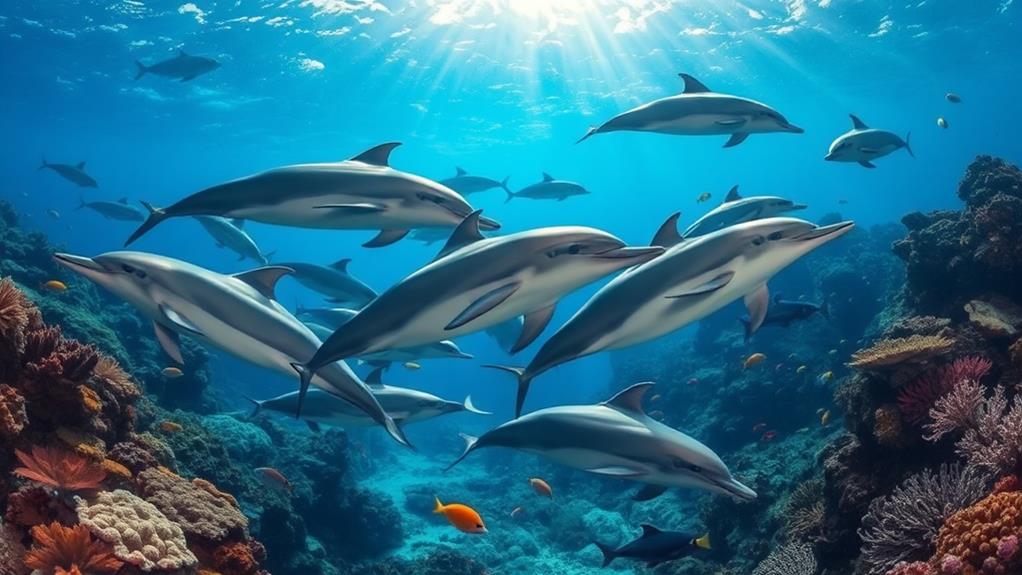Philippine dolphins exhibit remarkable diversity, with nearly half of the country's cetacean species found in the Tañón Strait. This diversity is evident in the presence of various species, including the bottlenose dolphin, spinner dolphin, and Fraser's dolphin.
Human activities pose significant threats to dolphin populations. Unregulated fishing practices and tourism disrupt their habitats, reducing their food sources and increasing the risk of entanglement.
For instance, fishing nets can trap and kill dolphins, while tourist boats can disturb their natural behavior.
Newly discovered species highlight the need for continued research. The rose-bellied dwarf spinner dolphin, a recently discovered species, suggests ongoing ecological shifts in the region.
This underscores the importance of continued research to understand and protect these marine mammals.
Engaging local communities is crucial for conservation. By promoting sustainable practices among local communities, we can reduce the impact of human activities on dolphin populations.
This can be achieved through education and outreach programs that raise awareness about the importance of dolphin conservation.
Overview of Philippine Dolphins

The Philippines is home to a diverse range of dolphins, with nearly half of the recorded cetacean species found in the Tañon Strait. This area is a habitat for iconic marine mammals such as the Indo-Pacific bottlenose dolphin (Tursiops aduncus) and the Risso's dolphin (Grampus griseus).
Recent surveys indicate a decline in dolphin sightings, with only 15 recorded across six species, marking the lowest encounters since 1999. Despite their presence, the number of dolphins seen in the area has decreased. This decline is cause for concern and highlights the need for more research and monitoring.
Indo-Pacific bottlenose dolphins play a crucial role as indicators of ocean health, reflecting the overall state of their marine environment. For example, the Indo-Pacific bottlenose dolphin was first confirmed in the Philippines through a stranding in Luzon in 2010, yet sightings remain sparse. This highlights the need for more research and monitoring to understand the health of the ocean.
Conservation efforts are vital to protect dolphins from human activities like fishing and tourism that threaten their habitats.
Increased awareness and action are necessary to ensure the survival of Philippine dolphins and the biodiversity they represent. By understanding the challenges they face, we can contribute to the conservation of these remarkable marine mammals and help safeguard their future in the rich waters of the Tañon Strait.
Species Diversity in the Region
The Taño Strait is home to a remarkable array of cetaceans, with 48% of the Philippines' recorded cetacean species found in the region. The Indo-Pacific bottlenose dolphin (Tursiops aduncus) is a notable resident, with its presence confirmed since the late 1980s. Other species, such as Bryde's whale and the rose-bellied dwarf spinner dolphin, have also been spotted, highlighting the strait's ecological richness.
However, recent surveys indicate a concerning decline in cetacean sightings. Only 15 encounters across six species were recorded, emphasizing the urgent need for conservation efforts in the region. Historically, species like the gray spinner dolphin and dwarf sperm whale thrived in the Taño Strait, but some, such as the short-finned pilot whale, haven't been seen since 1999.
Ongoing research is crucial to monitor the health of these dolphin populations and their habitats. Protecting this unique species diversity is vital not only for the cetaceans themselves but also for the overall marine ecosystem in the Philippines.
Importance of Marine Ecosystems

Marine ecosystems are crucial for sustaining biodiversity and providing essential resources for coastal communities. In the Philippines, the Taño Strait is a critical region, hosting 48% of cetacean species found in the country. This diversity highlights the importance of marine biodiversity in maintaining ecological balance.
The Strait's varied habitats, including 12 distinct seagrass species and 22 mangrove species, support juvenile fish and crustaceans, forming the backbone of local fisheries. These habitats provide a safe haven for young marine life to grow and thrive.
Coral reefs are vital habitats for numerous marine species, with approximately 8,408 hectares of coral reefs in the Taño Strait. Dominant coral genera like Acropora and Porites create intricate environments essential for marine life.
The Philippine Sea, part of the Coral Triangle, boasts over 2,000 fish species and 400 coral species, indicating its ecological significance.
Over 1 million Filipinos depend on these marine resources for their livelihoods, highlighting the need for marine protected areas to ensure sustainability.
Conservation Status and Challenges
Conservation Status of Dolphins in the Philippines
The conservation status of dolphins in the Philippines is a pressing concern. The Indo-Pacific bottlenose dolphin, classified as Data Deficient by the IUCN Red List, highlights the lack of sufficient data to evaluate its population trends and conservation status. Another species, the spinner dolphin, is listed as Near Threatened due to threats from fisheries bycatch and potential disturbance from human activities, such as diving adventures on Panglao Island. Efforts are being made to safeguard these intelligent and charismatic creatures through the establishment of marine protected areas and the implementation of responsible tourism practices. However, continued research and monitoring are essential to effectively conserve the diverse dolphin species found in the Philippines.
Threats to Dolphin Populations
Human activities, particularly fishing and tourism, pose significant threats to dolphin populations. In the Taíno Strait, 101 vessels were identified in 2019, disrupting dolphin behavior and habitat.
The fluctuating appearances of bottlenose dolphins, reappearing in 2008 and 2019 after a notable absence, further complicate our understanding of their populations.
Conservation Challenges
Illegal fishing practices and insufficient law enforcement hinder effective conservation efforts. Stricter regulations and community involvement are essential to protect vulnerable dolphin species and their habitats.
Continuous monitoring and research are necessary to address the complex conservation challenges facing dolphins in Philippine waters.
Human Impact on Dolphin Populations

Human Activities Affect Dolphin Populations
Human activities have a significant impact on dolphin populations in the Philippines, particularly in areas like the Taínon Strait.
Only 15 sightings of six species were recorded in the latest survey, a stark contrast to previous years.
Four Key Impact Factors
There are four main factors contributing to the decline of dolphin populations:
Marine Traffic: Heavy boat presence, including 101 vessels in 2019, disrupts dolphin habitats and behavior. This is particularly concerning in areas with high marine traffic, such as the Taínon Strait.
Commercial Fishing: The intrusion of fishing vessels decreases food availability and increases entanglement risks for dolphins.
Fishing gear and nets can entangle and harm dolphins, making it essential to implement sustainable fishing practices.
Dolphin Tours: Crowding during dolphin-watching activities increases stress and displacement of dolphins.
Responsible tourism practices are crucial to minimize disturbance to dolphin habitats.
Conservation Needs: Balancing protection and community needs complicates management strategies.
Effective conservation requires a collective commitment to sustainable practices, ensuring the long-term survival of dolphin populations.
Urgent Need for Action
To protect dolphin populations, enhanced law enforcement and sustainable fishing practices are essential.
Research Methods and Findings
Documenting Dolphin Populations in the Taúñon Strait
Researchers effectively document dolphin populations in the Taúñon Strait through rigorous boat-based photo-identification surveys. These surveys involve meticulously gathering data over extensive hours.
In 2014 and 2015, surveys totaled 669 hours over 92 days, focusing on the Indo-Pacific bottlenose dolphins (Tursiops aduncus).
Key Findings
Fifty encounters led to the cataloging of 121 individual dolphins. Group sizes ranged from solitary individuals to approximately 60, with an average of 11, revealing social structures.
Sightings occurred at various distances, from 20 meters to 11 kilometers offshore, indicating diverse habitat utilization. The Indo-Pacific bottlenose dolphin is classified as Data Deficient by the IUCN Red List, highlighting the urgent need for further research to assess its conservation status within marine protected areas.
Ecological Significance and Conservation
Understanding the dynamics of dolphin groups and their habitat use is crucial for conservation efforts. This knowledge ensures that strategies are in place to protect these marine mammals in their natural environment.
Documenting dolphin populations not only provides valuable data but also highlights the importance of conservation efforts.
New Species Discoveries

The Taúñon Strait is a hotspot for cetacean diversity due to its unique combination of geographical and oceanographic features.
Recent discoveries, like the sighting of rose-bellied dwarf spinner dolphins, illustrate the area's potential for new dolphin species. This sighting marks only the second recorded instance of this subspecies in Philippine waters, indicating a possible adaptation or migration.
New species discoveries are vital for conservation efforts, as they help understand the distributional ecology of cetaceans.
Despite a historical decline in marine mammal species, including the short-finned pilot whale and melon-headed whale, the Taúñon Strait Protected Seascape serves as an important migratory route for vulnerable marine mammals. Ongoing research highlights gaps in monitoring and documenting this high diversity of cetaceans, emphasizing the need for comprehensive data collection.
With every new marine mammal species confirmed, we contribute to a deeper understanding of the region's biodiversity. Protecting and studying these dolphins not only aids conservation but also enriches our knowledge of the complex dynamics within cetacean populations.
Community Involvement in Conservation
Community Involvement is Crucial for Conservation
The rich biodiversity of the Taúñon Strait relies heavily on community involvement in conservation efforts. Local residents play a vital role in sustaining dolphin populations and protecting marine ecosystems.
Residents Take Ownership Through Monitoring
Local residents monitor dolphin populations, fostering a sense of stewardship. This direct involvement allows them to take responsibility for the well-being of the dolphins and their habitat.
Sustainable Practices Benefit Both People and Dolphins
Fishing communities adopt sustainable management practices, balancing their livelihood needs with marine biodiversity protection.
For example, they implement catch limits and fishing gear modifications to reduce bycatch and protect endangered species.
Education Raises Awareness and Promotes Action
Educational outreach programs raise public awareness about marine conservation and dolphins.
These programs inform people about the importance of conservation, encouraging them to take action to protect the marine ecosystem.
Collaborations Lead to Responsible Tourism
Collaborations between environmental organizations and local stakeholders promote responsible tourism, benefiting both the economy and the dolphins.
For instance, eco-tourism initiatives support local businesses while minimizing the impact of tourism on the environment.
Community Advocacy Combats Illegal Fishing
Community advocates address illegal fishing activities, emphasizing collective action for ecosystem protection.
By working together, they can effectively combat illegal fishing and protect the marine ecosystem.
Community Involvement Ensures a Conservation Culture
Community involvement is essential for fostering a culture of conservation.
By participating in educational programs and advocating for sustainable practices, communities empower themselves to act as guardians of their environment.
This collective effort ensures the long-term protection of the Taúñon Strait's unique marine biodiversity.
Recommendations for Sustainable Practices

Sustainable Practices for Dolphin Conservation
Stricter Regulations and Sustainable Tourism
Implementing sustainable practices is crucial for protecting dolphin populations and the Tañón Strait's marine ecosystem. Stricter regulations on fishing and tourism activities are necessary to reduce disturbances caused by human activity, which significantly contributes to the decline of these marine mammals.
For instance, limiting the number of dolphin-watching tours can reduce crowding and stress on dolphins, ensuring their well-being.
Community Involvement and Monitoring
Community involvement in conservation efforts is vital for fostering a sense of responsibility among locals. Engaging the community can enhance support for protecting cetacean populations and their habitats.
Regular monitoring of marine traffic is necessary to assess its impact on dolphin behavior, allowing for informed management strategies that bolster conservation measures.
Educational Outreach and Public Awareness
Educational outreach programs are essential for increasing public awareness about the importance of dolphin conservation. By promoting responsible tourism and encouraging participation in marine protection initiatives, you can help create a more sustainable environment for dolphins.
Future Directions for Research
Future research on Philippine dolphins should prioritize comprehensive data collection to establish baselines for assessing population trends and conservation effectiveness. The protected waters of Tañon Strait, home to nearly half of the country's cetacean species, are crucial for this effort.
To advance conservation efforts, research should focus on the following key areas:
Monitoring dolphin behavior in heavily trafficked regions is essential to understand human impacts on sightings. For instance, studying the effects of shipping lanes on dolphin behavior can inform strategies to minimize disruptions.
Investigating migratory patterns of vulnerable small cetaceans is vital to inform targeted conservation strategies. By tracking the movements of these species, conservationists can identify critical habitats and develop effective protection measures.
Collaborating with local communities is critical to address illegal fishing and promote sustainable dolphin watching practices. This can involve educating local fishermen about the importance of sustainable fishing practices and engaging them in dolphin conservation efforts.
Exploring newly identified species, such as the rose-bellied dwarf spinner dolphin, is necessary to ensure their habitats are preserved. Research on these species can provide valuable insights into their behavior, habitat requirements, and population dynamics.
Enhancing public awareness about the importance of preserving diverse marine areas for ecological balance is crucial. This can be achieved through education campaigns, community outreach programs, and collaborative efforts with local stakeholders.
Questions and Answers
Are Dolphins Endangered in the Philippines?
Yes, dolphins in the Philippines are endangered due to various threats affecting their habitats and behaviors.
One significant threat is commercial fishing, which can result in dolphins getting caught in fishing nets and drowning.
Another threat is unregulated dolphin-watching tours, which can disrupt dolphin behaviors and habitats.
Conservation efforts are underway, but they require more local awareness and support.
For instance, research initiatives are crucial for understanding dolphins better and assessing the effectiveness of conservation strategies.
Promoting ecotourism benefits can help raise awareness and fund conservation actions for dolphin populations.
How Do Dolphins Contribute to Biodiversity?
Dolphins play a crucial role in maintaining biodiversity in marine ecosystems.
They regulate prey populations through their complex social behaviors, ensuring that no single species dominates the ecosystem.
For example, dolphins prey on fish that might otherwise overgraze seaweed forests, allowing these habitats to thrive.
Dolphins' feeding habits enhance nutrient cycling, promoting phytoplankton growth.
When dolphins feed on fish and squid, they redistribute nutrients throughout the ocean.
These nutrients are then absorbed by phytoplankton, which form the base of marine food webs.
Phytoplankton growth supports the entire marine ecosystem, from small fish to large predators.
Dolphins' interactions with humans promote habitat preservation and conservation awareness.
By observing dolphins in their natural habitats, humans develop a deeper appreciation for marine ecosystems and the need to protect them.
This awareness leads to conservation efforts, preserving habitats and promoting biodiversity.
What Is the Common Dolphins Conservation Status?
The conservation status of common dolphins is a pressing concern due to threats to their habitats and populations. The International Union for Conservation of Nature (IUCN) lists common dolphins as Least Concern, but some subspecies are Vulnerable or Near Threatened.
Community involvement in conservation strategies and research initiatives is crucial to assess these threats. For instance, regular threat assessments help identify critical issues impacting dolphin populations, such as bycatch, habitat degradation, and noise pollution.
Additionally, promoting responsible ecotourism can generate funding for conservation efforts and raise awareness about the importance of protecting dolphins and their environments.
How Many Irrawaddy Dolphins Are Left in the Philippines?
Fewer than 200 Irrawaddy dolphins remain in the Philippines. This critically low population necessitates immediate conservation efforts.
Habitat protection measures are essential to enhance their survival, alongside conservation funding sources that support local community involvement.
To effectively safeguard these dolphins, research and monitoring are crucial to understanding their needs, especially in the face of climate change impacts that threaten their environment.